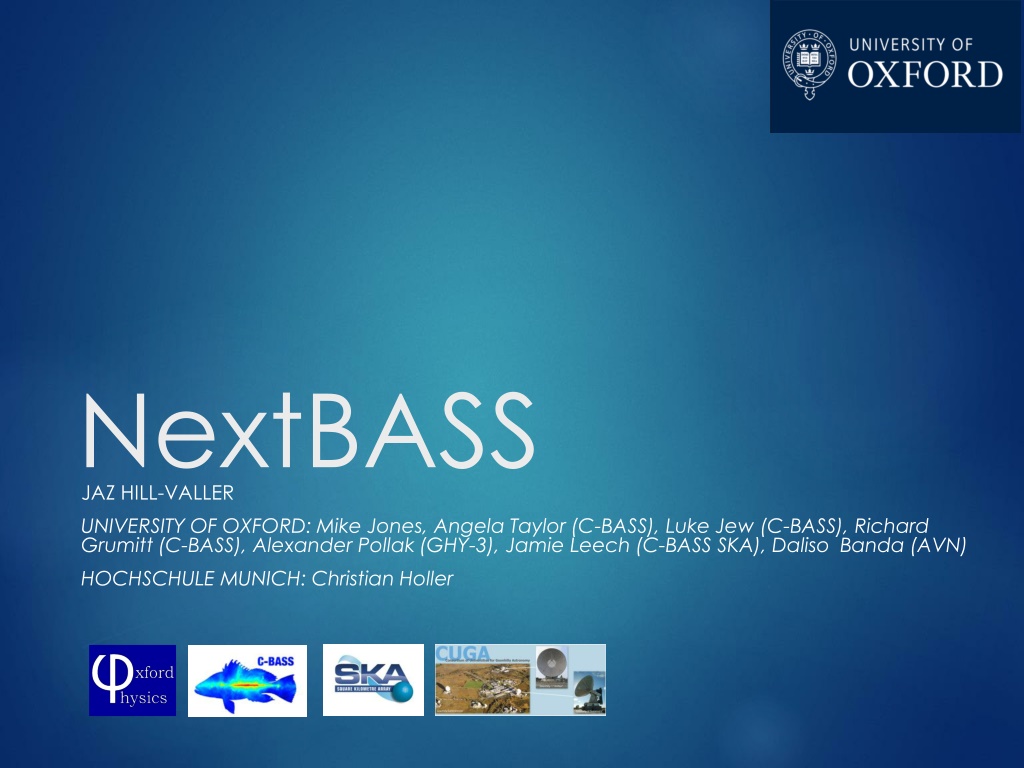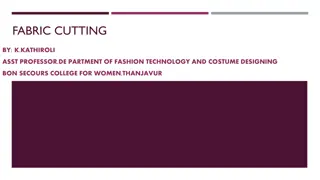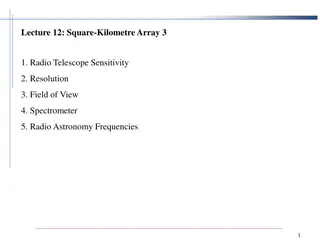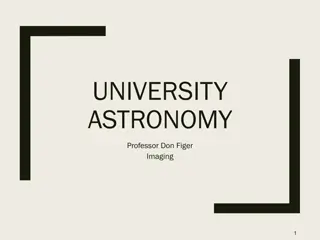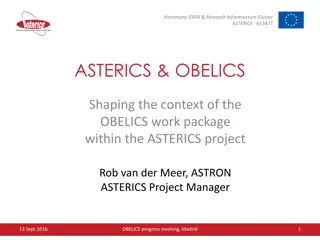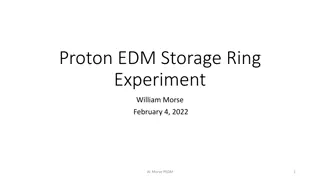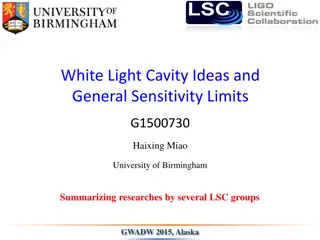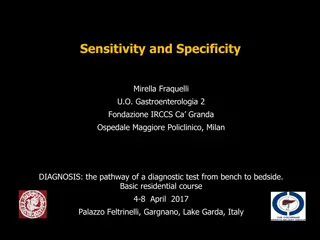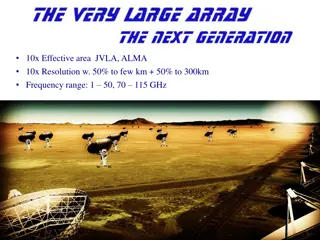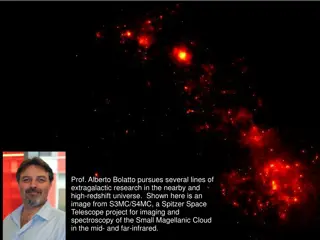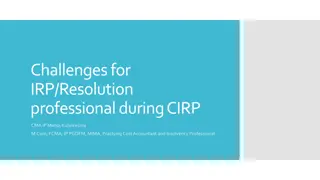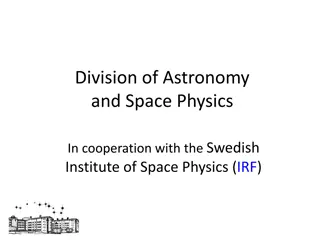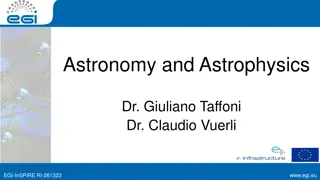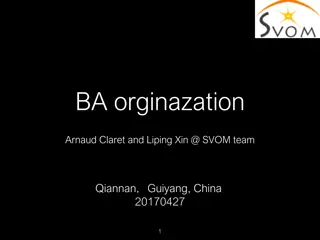Cutting-Edge Astrophysics Research at NextBASS: Advancing Sensitivity and Resolution
Cutting-edge research at NextBASS, a collaboration between University of Oxford and Hochschule Munich, aims to cover a frequency gap between 7-30 GHz with advanced technology. The project involves achieving equivalent sensitivity to future cosmic microwave background missions, utilizing multiple feeds and stages for optimal results. Sensitivity simulations, pixel-level analysis, and error modeling are key aspects of this groundbreaking initiative.
Download Presentation

Please find below an Image/Link to download the presentation.
The content on the website is provided AS IS for your information and personal use only. It may not be sold, licensed, or shared on other websites without obtaining consent from the author. Download presentation by click this link. If you encounter any issues during the download, it is possible that the publisher has removed the file from their server.
E N D
Presentation Transcript
NextBASS JAZ HILL-VALLER UNIVERSITY OF OXFORD: Mike Jones, Angela Taylor (C-BASS), Luke Jew (C-BASS), Richard Grumitt (C-BASS), Alexander Pollak (GHY-3), Jamie Leech (C-BASS SKA), Daliso Banda (AVN) HOCHSCHULE MUNICH: Christian Holler
Concept Cover frequency gap between 7-30 GHz 2 bands each covering total bw = 2:1 20% bw for each channel Achieve an equivalent sensitivity that matches future CMB missions 1 feed for 7-15 GHz 30+ feeds for 7-15 GHz 6m telescope to match resolution of C-BASS THREE STAGES: X-BASS NEXTBASS ELFS ? ? ?0 1???????? = ??
Tenerife Atacama 7 30 GHz 7 30 GHz Klerefontein 7 15 GHz
Sites and total survey time Total survey time = nyears*0.5 (night obs) *0.8 (usable data)
Sensitivities NextBASS, 5 years, 1 feed 7-15GHz, 30 feeds 15-30 GHz F I P [GHZ] 7.4 8.3 9.4 10.1 11.7 13.2 14.9 15.9 17.9 20.1 22.5 25.3 28.4 [uKdeg] 1.64 1.54 1.48 1.49 1.43 1.37 1.47 0.36 0.21 0.27 0.32 0.31 0.30 [uKdeg] 0.55 0.51 0.49 0.50 0.48 0.46 0.49 0.12 0.10 0.09 0.11 0.10 0.10
Single Pixel Simulations Estimate experiment sensitivity -> 1 deg pixels (I) and 3 deg pixels (P) Different combinations of experiments (add more freq. channels) Range of pixel regions with different foreground levels Generate Jeffreys Prior for each free parameter Three levels of complexity: BASIC, CURVED SYNCHROTRON, COMPLEX Intensity: Straight synch + curvature term + free to move free-free Electron temperature Polarisation: Straight synch + curvature term + 1% (of I) AME component Bayesian statistical methods + MCMC sampling algorithm Plot probability density function for each parameter Fit spectrum to each run & plot error bars NEXT STEP: ERROR MODELLING e.g. fitting a basic sky model to a complex sky
Basic Polarisation Model Planck + LiteBIRD Planck + LiteBIRD + C-BASS Planck + LiteBIRD + C-BASS + X-BASS Planck + LiteBIRD + C-BASS + NextBASS
add synchrotron curvature Planck + LiteBIRD Planck + LiteBIRD + C-BASS Planck + LiteBIRD + C-BASS + X-BASS Planck + LiteBIRD + C-BASS + NextBASS
add 1% polarised AME Planck + LiteBIRD Planck + LiteBIRD + C-BASS Planck + LiteBIRD + C-BASS + X-BASS Planck + LiteBIRD + C-BASS + NextBASS ABAME = 1% (AIAME)
Planck + LiteBIRD + C-BASS B POL CMB AMP = 0, BRIGHT GALACTIC PLANE
+ X-BASS B POL CMB AMP = 0, BRIGHT GALACTIC PLANE
+ NextBASS B POL CMB AMP = 0, BRIGHT GALACTIC PLANE
NextBASS Optical Design 6m Cross-Dragone Off-axis Gregorian also possibility (FP smaller/not uniform)
Ground Shield Based on QUIET optical baffling & ClOVER shield Modelled as perfect absorber Housing reduces far sidelobes Baffle gets rid of secondary spillover Improves cumulative power Meaning higher beam efficiency l tan ? = ?/?
X-BASS Optical Design 1 feed, 7-15 GHz C-BASS South Dish 2016 Photogrammetry data RMS surface accuracy ~ 2,63mm Will work up to 15GHz Profiled corrugated horn CHAMP Optimisation
NextBASS Feed Design for CXD 25 dB horn = optics
Performance of NextBASS Feed with CXD 99% of total power within 1 degree beam without shielding!
X-BASS Feed Design for on-axis Cassegrain CHAMP profile optimised feed Cubic spline profile of 10 points Optimised to match the C-BASS South feed horn pattern
Performance of X-BASS Feed with C-BASS South Optics maximum ECX of -30 dB
Receiver Linear polarisation Convert to LCP & RCP in FPGA Xilinx RF system on-chip, 14 bit, 4 GSPS (X-BASS) Intel (Altera) Stratix 10 DRAM SiP, 3.5 bit, 20 GSPS (NextBASS)
Technology Development 2:1 bandpass filters, anti-aliasing filters using microstrip 2:1 bandwidth quad-ridge ortho-mode transducer (A. Pollak in prep) Continuous wave stabilisation (GHY-3 - A.Pollak, C.Holler) Reference signal then calibrates for whole band Reduces number of RF channels compared to C-BASS from 4 to 2
TRL? TRL9We have it, we ve tested it and it works TRL8We ve done the commissioning tests TRL7 We ve tested the whole thing in the field TRL6We ve tested the whole thing in the laboratory TRL5We ve modelled it and tested in the field TRL4 We ve modelled it robustly and tested it in the lab TRL3There has been a proof of concept TRL2The design concepts have formulated TRL1Its been scribbled on the back of the envelope somewhere
Part X-BASS TRL NextBASS TRL Telescope Feed Horn C-BASS South Profiled corrugated feed [DP] + ring-loaded slots, 2:1 bw (7-15 GHz) GH3 (A. Pollak & C. Holler) 2:1 BW under development 9 4 CXD, baffle & ground-shield hyperbolic corrugated feed [DP] + ring-loaded slots, 2:1 bw (7-15 GHz & 15-30 GHz) 3 4 CW OMT 4 4 GH3 (A. Pollak & C. Holler) 2:1 BW under development 4 4 LNA LNF-LNC6-20C, 6 to 20 GHZ 9 LNF-LNC6-20C, 6 to 20 GH, LNF-LNC15-29B, 15 to 29 GHz LNA Micro-strip, tested 7-15 GHz Micro-strip, un-tested 15 30 GHz HMC994Achip 9 BPF Micro-strip, tested 7-15 GHZ 5 4 RF Amplifier Mixer/LO AAF IF Amplifier ADC A0X20, 2-20 GHz 9 9 HMC733/HMC1048A Micro-strip, 0 2 GHz CBASS IF XILINX UltraScale RF System on- chip XILINX UltraScale RF System on- chip 9 9 9 6 HMC292ALC3BTR Micro-strip, 0 9.5 GHz A0X20 HDMCAD5831, 3.5 bit, 20 Gbps 9 4 9 4 FPGA 6 Intel (Altera) Stratix 10 DRAM SiP 3
Summary From forecasting 7-30 GHz needed to constrain realistic foregrounds Complete coverage over this frequency range is technologically attainable Large scale low frequency CMB foreground project is essential to complement CMB-S4 and satellites
